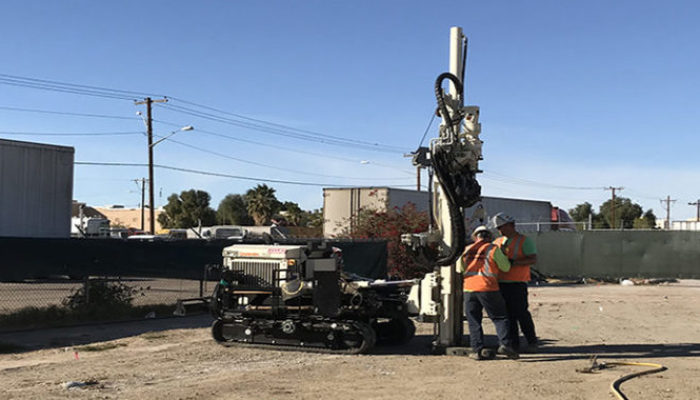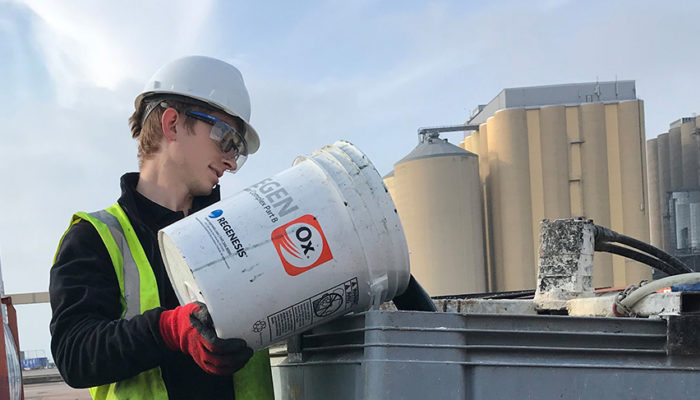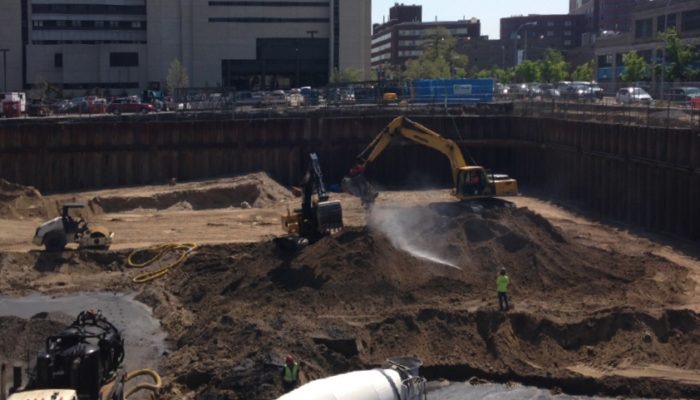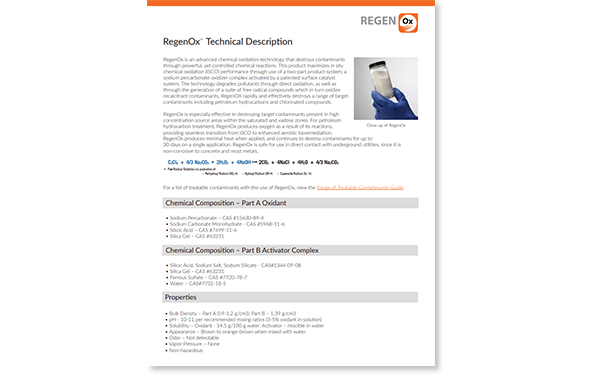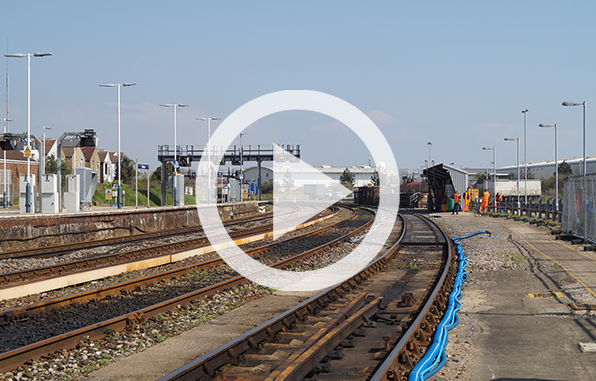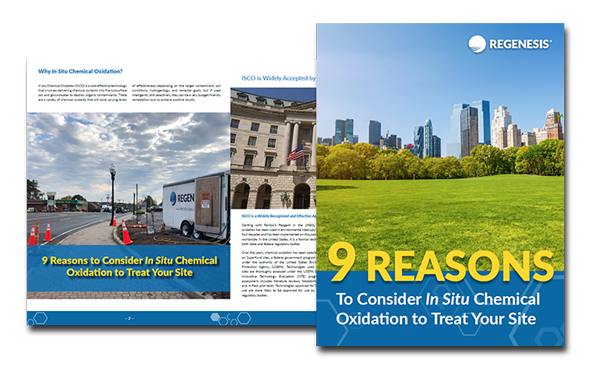
Safe and Effective In Situ Chemical Oxidation (ISCO)
At a glance
-
Provides rapid contaminant destruction
-
Targets source areas of highly impacted groundwater
-
Surface mediated chemical oxidation avoids temperature and pressure build-up
-
Compatible with most construction materials allowing application near to infrastructure
Benefits
-
Highly effective at rapidly destroying large amounts of contaminant mass
-
Safe to use
-
Easy to mix and apply
-
Compatible with infrastructure
-
Treatment sustained for 4-5 weeks from a single injection
-
Combines well with aerobic biological degradation
-
Minimised loss to natural FOC on soils, through desorption and destruction of contamination in groundwater
-
Effective desorption reagent to enhance physical recovery techniques
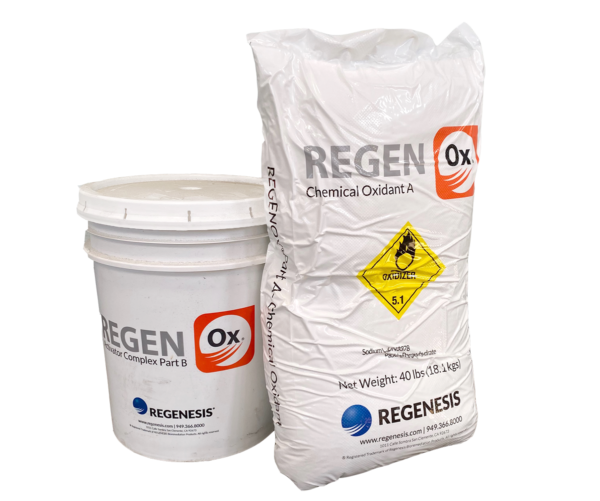
TARGET CONTAMINANTS
Petroleum Hydrocarbons
-
Benzene, Toluene, Ethylbenzene and Xylenes (BTEX)
-
Gasoline Range Organics (GRO) (C6-C10-12)
-
Diesel Range Organics (DRO) (C8-12-C24-26)
-
Oil Range Organics (ORO) (C22-32)
-
Creosote (coal tar)
-
Methyl-Tertiary Butyl Ether (MTBE)
-
Tert-Butyl Alcohol (TBA)
For a complete listing of treatable contaminants please visit our Range of Treatable Contaminants Page.
Chlorinated Compounds
-
Chlorinated Solvents
-
Tetrachloroethylene (PCE)
-
Trichloroethene (TCE)
-
cis-1,2 Dichloroethene (DCE)
-
Vinyl chloride (VC)
-
Tetrachloroethane
-
Trichloroethane (TCA)
-
Dichloroethane (DCA)
-
Carbon tetrachloride
-
Chloroethane
APPLICATION METHODS
Typical applications include:
-
Direct-push injection
-
Injection into wells
-
Sprayed into excavation
Enhancing recovery techniques:
-
Multi-phase extraction
-
Vacuum tanker extraction
-
Pump and treat systems
For more information, please read the Application Instructions
ENGINEERED ISCO REAGENT
A two-part system that produces powerful chemical oxidation reactions
RegenOx® in situ chemical oxidation (ISCO) directly oxidizes contaminants while its unique catalytic component generates a range of highly oxidizing free radicals that rapidly and effectively destroy a range of target contaminants including both petroleum hydrocarbons and chlorinated compounds.
RegenOx is an injectable, two-part ISCO reagent that combines a solid sodium percarbonate based alkaline oxidant (Part A), with a liquid mixture of sodium silicates, silica gel and ferrous sulfate (Part B), resulting in a powerful contaminant destroying technology.
Once emplaced in the subsurface, RegenOx produces a cascade of highly-efficient chemical oxidation reactions via a number of mechanisms including:
- Surface mediated oxidation
- Direct oxidation
- Free radical oxidation
These reactions destroy a range of contaminants and can be propagated in the presence of RegenOx for periods of up to 30 days on a single injection.
RegenOx produces minimal heat and pressure and is non-corrosive making it a relatively safe chemical oxidant that is compatible for use in direct contact with underground infrastructure such as utilities, tanks, piping communication lines, etc. As a result the material can be applied using a wide-range of standard field equipment (e.g. direct push injection rigs) or applied directly into excavations.
In addition to chemical destruction, RegenOx ISCO produces a significant, short-term oxygen footprint that is optimal for establishing aerobic conditions capable of supporting follow-on, aerobic biodegradation of petroleum hydrocarbons. Once aerobic conditions are in place, many remediation practitioners apply Oxygen Release Compound Advanced (ORC Advanced) with or after RegenOx to support long-term aerobic biodegradation. This “ISCO to bio” combined remedies approach can be highly effective at reducing a range of contaminant concentrations and associated costs.
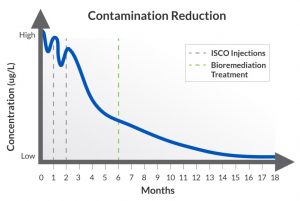 Finally, RegenOx based-reactions produce mild, detergent-like effects that desorb or remove contaminants off of soil surfaces and transfer contaminants more readily into the dissolved-phase. This process of removing material from soil surfaces has also been proven to be highly effective at increasing the efficiency of established, groundwater pump and treat (P&T) systems that have gone asymptotic. This desorption effect has been optimized in a specialized version of RegenOx called PetroCleanze which is designed for use in enhancing and optimizing multi-phase extraction (MPE) activities and P&T systems during site remediation.
Finally, RegenOx based-reactions produce mild, detergent-like effects that desorb or remove contaminants off of soil surfaces and transfer contaminants more readily into the dissolved-phase. This process of removing material from soil surfaces has also been proven to be highly effective at increasing the efficiency of established, groundwater pump and treat (P&T) systems that have gone asymptotic. This desorption effect has been optimized in a specialized version of RegenOx called PetroCleanze which is designed for use in enhancing and optimizing multi-phase extraction (MPE) activities and P&T systems during site remediation.

 Americas
Americas Europe
Europe Français
Français Deutsch
Deutsch Italiano
Italiano Español
Español